As of September 2016 there is a new DNA testing company battling for consumers money, Living DNA. They offer a single, €159/£120/$159 , 3-in-1 test, covering autosomal, male-line yDNA (males-only duh) and maternal-line mitochondrial DNA. Even though I’ve already taken a bunch of DNA tests there are still some things that make this test interesting for me.
- There is a a heavy focus on genetic heritage – where in the world do your ancestors come from. Currently they aim to match your DNA against 80 worldwide reference populations (see fig. 1). More importantly LivingDNA follows on from the People if the British Isles project and breaks Great Britain into 21 regional areas, (see fig. 2 below).
- The company is British, I’m British, so I like to support British companies. More seriously, the company has a very structured, privacy-orientated approach to your data, security (they are ISO:9001 certified for quality controls and ISO:27001 for information security) and how your data is used.
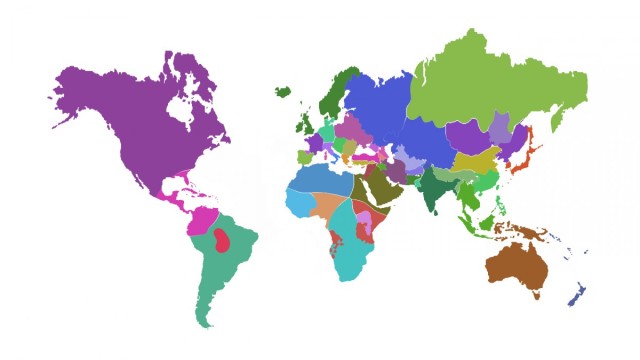
fig 1. The 80 worldwide regions LivingDNA can use to break down your ethnicity. Source: https://www.livingdna.com/en-eu/worldwide-ancestry-regions
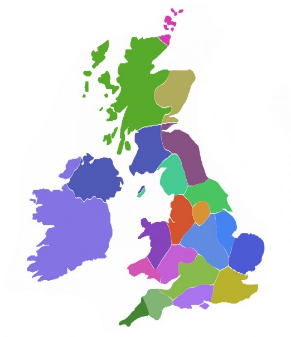
fig. 1. How British ethnicity is broken down. Source: https://www.livingdna.com/en-eu/uk-regional-breakdown
If you are interested in the technical details of the LivingDNA test, then this paragraph from their launch PR probably covers most of the stuff you will be in interested in:
“Living DNA’s test itself is run on a custom-built “Living DNA Orion Chip”. It is one of the first bespoke DNA chips in the world to be built using the latest GSA technology from market leader Illumina, and tests over 656,000 autosomal (family) markers, 4,700 mitochondrial (maternal) markers and 22,000 Y-chromosomal (paternal) markers.”
Family Ancestry
This is the most exciting part of the testing for me. Would the LivingDNA test provide any new insights into my genetic ancestry ? To see how well my paper-trail ancestry matches LivingDNA’s genetic ancestry it’s probably best to have a quick introduction to my ancestors.
My Ancestors
To understand my genetic ancestry it’s best to have a look at my great-grandparents. They mostly came from small villages that you’d be hard-pressed to identify on a map, such as Gt. Broughton (N. Yorks), Hawnby (N.Yorks), Lissan (Co. Derry) and Santon (Norfolk), the later village being too small for Google to find.
Only a couple came from larger towns, specifically York and Darlington. My York-born ancestor, Sarah Sturdy, actually had all four of her grandparents born within 5 km of each other near Masham, a Yorkshire village famous for it’s breweries (Theakstons and the rebel Black Sheep breweries). My Darlington ancestor, Maria Singleton Armstrong was probably the most cosmopolitan of the 8 great-grandparents, but her ancestors were weavers and wool-combers, although the name Armstrong is linked with the Border Reivers.
In preparation for these results written up some more details on my great-grandparents and their grandparents. This can be read at “32 Ancestors – The people who didn’t move much” but it might be easier to look at the following map. The black markers show my great-grandparents, the coloured markers my ggg-grandparents. Of the 32 ggg grandparents I know 29 and have reliable birth/baptism records for 23.
An alternative way to visualise my ancestors is to use the methodology that created the #MyColorfulAncestry pedigree chart. This is my version, adapted to both LivingDNA’s 21 regional populations and their colour scheme. I’ve added a little more information to the chart to help people get a sense of the social background of these people.
As you can see all but one of my great grandparents represents a block of 4 people, all from the same LivingDNA region. The one exception is Robert Hall, who was an ancestor of Robert Smith. Robert Hall was born in the village of Whorlton, which is situated on the Durham side of the river Tees. LivingDNA rather inconveniently has a border between North Yorkshire and Northumbria somewhere around the Tees. I personally believe that there wouldn’t be much genetic distance between people on the north and south banks of the Tees. In addition, I have other examples in my family where people moved between villages on the north and south banks of the Tees. On this basis I’m happy to simplify things and include Robert Hall in the North Yorkshire population. Once this is done (and assuming equal inheritance from each ancestor) we get a very simple regional “recipe” of my ancestors, as follow:
1/2 North Yorkshire
1/4 East Anglia,
1/8 Northumbria
1/8 Southwest Scotland and Northern Ireland.
LivingDNA Family Ancestry (aka your Ethnicity)
Lets start with the most basic news. The LivingDNA test has me down as British. I’m down as 94.1% British, with a slightly anomalous 1.7% Southern European (actually assigned as Basque). I’ll leave the Basque part out of any further commentary since I try not to worry about any trace ethnicities (say under 5%).
LivingDNA further split out my Great British and Ireland ancestry out into British regions (or sub-regional in LivingDNA terms), and this is where it gets interesting. These are their results.
It may be easier to see how these results compare with my expectations in a simple table (see below). As you can see there are some unusual results. Specifically the results vary from expectations as follows:
- The low representation of my North Yorkshire ancestry.
- The lack of any reported Southwest Scotland and Northern Ireland ancestry, where I would have expected to see my Ulster Plantation ancestors.
- The introduction of LivingDNA regions Southeast England, Lincolnshire, Cumbria, South Yorkshire and North Wales.
| Region | Expected Result (%) | LivingDNA Estimate (%) |
|---|---|---|
| North Yorkshire | 50 | 11.8 |
| East Anglia | 25 | 21.4 |
| Northumbria | 12.5 | 11.0 |
| Southwest Scotland and Northern Ireland | 12.5 | 0 |
| Southeast England | 0 | 12.7 |
| Lincolnshire | 0 | 9.1 |
| Cumbria | 0 | 8.6 |
| South Yorkshire | 0 | 7.5 |
| North Wales | 0 | 2.4 |
Regarding the first and third irregularity (low North Yorkshire representation), I think there are two main ways we can interpret this. Obviously one possibility is that there are errors in my research, for example NPEs (Non-Parental Events), or errors in my identification of my ancestors. I don’t exclude this option.
The alternative may be to say that LivingDNA is challenged to separate out the relatively homogeneous central and eastern English cluster. Indeed the original People of the British Isles report bulked this group together as one category, that represented roughly half of the PoBI sample group.
Regarding the lack of any Southeast Scotland and Northern Ireland ancestry I must admit I’m a little surprised, especially given that two of my confirmed DNA relatives are from my Stewart line. I know that the Ulster Plantation was not just a Scottish affair but I would have expected to see something. Clearly an area that needs further research.
The addition of South Yorkshire ancestry is interesting. The PoBI study suggested this may be a trace of the Brittonic kingdom of Elmet. Perhaps this represents my Masham-based ancestors, who perhaps more connected with the other Yorkshire Dales folk than with the Vale of York.
yDNA results
Prior to my LivingDNA tests I’ve had a couple of yDNA tests. At FamilyTreeDNA I did the yDNA 37 marker test and have been categorised as I-M253 (I1 in the old money). On top of this I did the Geno 2.0 test from the National Geographic Society’s Genographic Project. I transferred the Geno 2.0 datat to FamilyTreeDNA. In both cases they gave me the downstream (i.e. more refined) haplogroup I-Z138 (I1a2b).
In addition I’ve been part of the I1-Z138 Project. With their assistance (and with information from nevgen.org) I’ve done further SNP testing at yseq.net which brings me forward to haplogroup I-S2268. This SNP has a Time to Most Recent Common Ancestor (TMRCA) of 2100 before today.
My LivingDNA yDNA result is consistant with my other testing and has me down as:
I was hoping to see if the yDNA test included any of the downstream SNPs (S2293, Z2541 and S2268 in my case). There is a feature within LivingDNA that allows you to download your results, but this feature has yet to be enabled. I’ll update here when I know more.
The yDNA test results, as well as the mtDNA results both have Haplogroup distribution maps (similar to the ones at eupedia), Haplogroup histories, a Migration Map and the relevant Phylogenetic Tree. Sadly the tree doesn’t have any TMRCA (Time to Most Recent Common Ancestor) information.
Mitochondrial DNA results
I’ve already done the full mitochondrial sequence (FMS) test at FamilyTreeDNA. My results are written up here. Bottom line is that I’m mDNA haplogroup I2 with the addition of the rather rare mutation in HVR1 C16259g. The net result of this is that I’ve no matches within the FamilyTreeDNA database at either the HVR1 or HVR1+HVR2 levels.
LivingDNA again produce the same result:
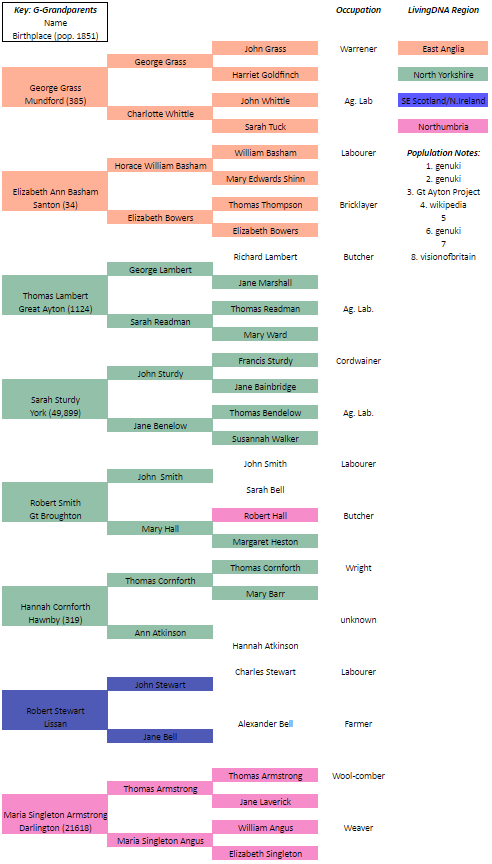
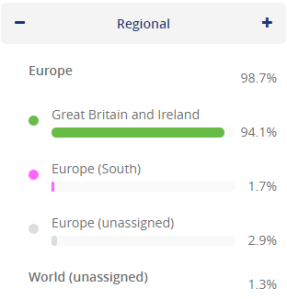
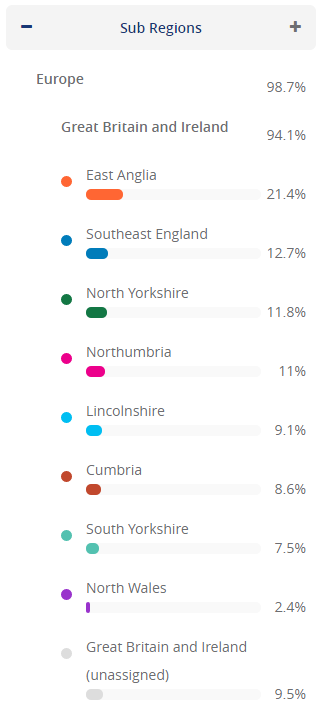
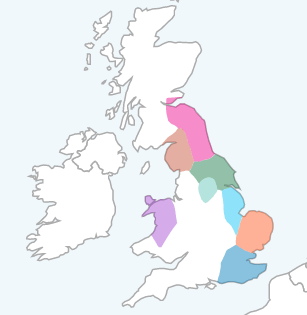


Hello Englishman in Frankfurt (Oder or Main?),
I am a Dutchman who had his y-dna tested at FT DNA and YSEQ (Berlin). My results are I-M253, subclades Z-138, DF29, Z2541 and Y-7043, which puts me at the end of a line starting in continental northwest Europe., in other words among the tribes of the west-atlantic Germans, called ingvaeones by Tacitus. Not surprisingly many of my closer genetic relationships are in Norway and Sweden. But interestingly – and this is the reason I write to you – two very close genetic relationships are in Medieaval Kent and in Somerset. I think these people from England and I have roots in Jutland. It is very well possible you have roots there too. You hadn’t expected a 12,7 percent “heritage” in southwest England, had you?. Well, this may be the reason. John Morris has written a very interesting book “The Age of Arthur” (used, ca. 10 euros at Amazon) Buy it, read it and have a wonderful Doppelkorn with it (Cigar Special von Rüdiger Sasse bei Münster ist laut schottischen Urteilen “best continental whisky” und erhielt den ersten Preis! Aber O’Donnell Moonshine ist auch nicht schlecht)
Hi Herbert,
Thanks for your comments, some quick answers:
1. Frankfurt am Main
2. Thanks for your info on the spread of I-Z138. I found you on the I-Z138 Project phylogenetic tree – I’m further down the tree with English/Irish and anothe Dutchman. My feeling is that my yDNA roots are from the North Germany/Jutland area. My oldest know ancestor is from Brandon, Suffolk i.e. deepest East Anglia, which kinda hints at an Anglian ancestry. The surprise southeast England ancestry I mention is actually from my autosomal DNA testing.
3. I look forward to trying the Cigar Special von Rüdiger Sasse bei Münster – I’ve put it on my list to track down. In the mean time my wife’s family would recommend this brennerei http://www.kornbrennerei-boeckenhoff.de/, although admittedly their products are more korn than whisky.
Hello Philipp,
Thanks for the link. Raesfeld is also in Münsterland, not far from my “Heimat” in the eastern part of the NL. In the borderregio they are good at “brennen”.
According to the draft tree you are also Z-2541, but somewhere between 1800 BC and 200 BC one of your ancestors had a different mutation from mine.
The Jutes came supposedly from the borderregion of Norway and Sweden, a land called Bohuslän. From there they sailed to the south baltic coast and then onwards to “Jutland”.
In the fifth century they spread to Kent (the bulk) and Frisia (a couple of families). I have many genetic relations in the Bohuslän region, apart from those in Kent and Somerset. This is why I think I have Jutish roots.
Herbert
Hello! Interesting post, that I came to via LivingDNA on Twitter.
I took one of their tests too. It was my first, so I have no comparators with other companies. I wrote briefly about my results here: http://www.cosmicsurfer.co.uk/?p=2870 although in time I’ll need to do a more considered post.
Those thoughts were based on my initial result: my autosomal result is 100% British, which was originally shown for ‘5 or 6 generations’ back. It was then updated to go back around 10 generations and Cornwall suddenly appeared in the mix.
I’m not sure where it gets me though. As interested as I am in the results, they go back 10 generations or so, and in pretty much every case all my lines fade away into uncertainty in the records about 6 generations back, 7 on a good day.
Even within those 6 known generations, there is a lot of room for uncertainty, as opposed to predictability. There is at least one case in my genetically recent (1843), family history where a father is either unknown or not recorded. There are a couple of instances of christenings coinciding with the marriage of the putative parents or happening an unfeasibly short time afterwards, and at least one ‘daughter’ who was probably in reality the illegitimate child of an older sibling. Two lines each disappear into Ireland in the early 19th/late 18th century. Another line (my mtDNA line as it happens) takes me back to the slums on either side of the Thames around 1805, and thence into mystery, at least so far as I have been able to research to date.
My conclusion is that, although they complement each other in many ways, the ‘truth’ revealed in the DNA results is unlikely ever to cohere fully with the ‘social truth’ presented in civil records and the like.
Ian
Edinburgh
Thanks Ian, I enjoyed reading your blog and your comments. I think your experiences are similar to many families in the UK, with research petering out around 6 or 7 generations as the availability and quality of Parish Registers goes downhill.
I was very interested to read your analysis of your LivingDNA results. I have just submitted a sample which is now in the testing regime. I too have had results from FamilyTreeDNA, but I was interested in the LivingDNA approach because I have many ancestors in North Yorkshire, more specifically the area around the North york Moors. I have identified the birth locations of 50 of the possible 60 ancestors to 3GG level. Of that 50, 48 were born in North Yorkshire, 1 in East Yorkshire and 1 in Durham. There is a gap in my tree because my maternal Grandfather was illegitimate, born in the workhouse in Helmsley with no father recorded on his birth certificate, so I guess it is possible that there may more North Yorkshire ancestors.
I was interested to see that you have an ancestor in Great Broughton, my father was born in Great Broughton and the family lived there from around 1912 to the 1950’s. The only picture that I have my paternal grandfather is of him with the Great Broughton cricket team prior to World War 1.
My paternal male line are all from the western edge of the North York Moors, mainly villages such as Osmotherley, Kepwick, Appleton Wiske, Great Smeaton, Husthwaite and Kilburn. The paternal female line are from the northern part of the North York Moors, again villages such as Egton, Danby, Ruswarp and Middleton on Leven. That line contains one Durham ancestor.
My maternal male line is mainly from Bilsdale, not far from Hawnby which appears in your tree. The maternal female line is mainly from the southern edge of the North York Moors around Pickering.
My FamilyTreeDNA results show that father line is Haplogroup G and my motherline is H1. More specifically:
yDNA
Haplogroup: G
Subclade: G-FGC14522 (On the FTDNA database only two others with this subclade, one in Belgium and the other in Germany)
MtDNA
Haplogroup: H1
Subclade: H1* – 10049G (On the FTDNA database only one other in Sweden)
I should get my LivingDNA results in about 10 weeks time, so I shall be interested to see what they come up with.
John Goldsbrough
Hi John,
Many apologies, your comment somehow got caught up in a Spam queue. I think your father may well have known my grandparents, Robert & Minnie Smith, and even my Mum (Gwen), who was born in Broughton in 1929. Robert was a farmer/butcher who lived in the Holme. I’d love to hear about your LivingDNA results when the get published, in part because you seem an ideal sample for “Moors folk”.
Thanks also for sharing you Haplogroup info. It’s always interesting to see how your haplogroup matches spread over Europe.
Best Wishes,
Phil
PS. Among my Bilsdale ancestors are Barrs, Chapman, Cornforth, Atkinson, Barker and Harrison, I also have Tully an Mothersill from the Kepwick/Over Silton area. I wonder if we have any common ancestors ?
Thank you very much for your reply, I had wondered what had happened to my comment. My Fathers’ sister, Ruth Gouldsbrough was born in Great Broughton in 1928 and I am still in contact with her. It is possible that she knew your mother, they could have even been to school together! My Bilsdale ancestors also include Atkinsons and Chapmans. The Wright side of the family are from Kepwick, they were Blacksmiths. I am creating a website called The Genealogy of A North Yorkshire Family. I am still adding to it but you are welcome to take a look at http://www.johngoldsbrough.uk
Regards,
John
John,
Many thanks for the link, I had an enjoyable couple of hours reading your research. If it’s OK with you I plan to put a link up to your website. Hopefully you’ll update the website when your LivingDNA test is in.
PS. My Mum was born in 1929, and went to Broughton school and afterwards Yarm Grammer.
Thank you for your comments. It would be OK for you to put a link to my website. I will update the site with my LivingDNA results when they come in, probably in May. I am contacting my Auntie Ruth because she was born in Broughton the year before your mother so it seems likely that they were both at Broughton school at the same time.
Regards,
John
Pingback: 32 Ancestors – The people who didn’t move much | learnalittleeveryday
Pingback: WhoDoYouThinkYouAreLive! 2017 – a short summary | learnalittleeveryday
My LivingDNA results have just been posted. The yDNA and mtDNA match my FamilyTreeDNA results. The regional breakdown shows 54.4% North Yorkshire, 11.5% Northumbria and 11.2% Lincolnshire. I have a 2G Grandparent from South Durham and a 3G Grandparent from the Hull area close to Lincolnshire. I have posted more information on my website under the News page.
http://www.johngoldsbrough.uk/blogs/
Regards,
John
John,
Thanks for sharing your LivingDNA results. I think they show similar patterns to mine i.e. that there is a certain amount of spill-over from North Yorkshire to the other eastern English seaboard regions. Personally (and this is only my gut-feeling) I’m not sure you can blame this on any specific ancestor rather it’s a “genetic-bleed” between regions. The question is whether this is a feature of the very similar genetic groups, admixture between the populations or a problem with the LivingDNA methodology is something I’m not smart-enough to answer !
I see that LivingDNA have updated calculations of their Family Ancestry results. My result has changed considerably and is now more in line with what I know from my family tree. They now put my North Yorkshire percentage as 84.6%, compared to 82.3% on my family tree back 5 generations. I have updated my website to reflect this.
http://www.johngoldsbrough.uk/blogs/post/LivingDNA-Family-Ancestry-map-update/
Thanks for the update, I find it impressive that LivingDNA could call 85% of your DNA as North Yorkshire. (I actually had a look at your updated results fairly shortly after the change as I was curious how they had treated your results – mine certainly improved.)
BTW – I see that you have a Mary Chapman from Bilsdale in your tree. Do you have any more details of her ? I’ve some Chapmans amongst my ancestors (see https://learnalittleeveryday.wordpress.com/2017/05/15/the-chapmans-hawnby-nova-scotia-and-methodism/), so maybe we’re related through this line.
Although I haven’t been in touch for a while, I have just spoken with my Auntie Ruth on her 90th Birthday and she remembers your mother, in fact she went to birthday parties and christmas parties at the farm when she was a child, she actually knew her as gwenny. She is go to look out some photographs. JOHN
Living DNA is excellent for British autosomal DNA, but not as detailed when it comes to other regions.
My mother and father come from opposite sides of Europe, and are of completely different ethno-religious groups. My Y-haplogroup is R1a-Z93, which is South and Central Asian in origin. My paternal side is Eastern European. R1a-Z93 is pretty much non existent among Anglo-Saxon males. My mtDNA is H3, which is North African (Libyan) in origin. H3 is common throughout Europe, whereas, outside of Asia, R1a-Z93 only shows up in Eastern Europe, especially among Roma peoples and Ashkenazi Jews (who are descended from Khazars). I did the living DNA test to find out my haplogroups. Given that my paternal side is from Eastern Europe, I guessed that I would be R1a, but I had no idea what my mtDNA would be.
My autosomal DNA was very detailed when it came to my mother’s side, as she is from England, but less detailed when it came to my father’s side. It is disappointing that living DNA has no Ashkenazi autosomal markers, unlike other companies. Living DNA also over emphasizes British autosomal ancestry. Apart from having British autosomal DNA, I had Southern Italian and Near Eastern. A small percentage of French came up, but according to Living DNA when one is half British and half Italian one may get a small percentage of French. Given that the company was not convinced of any French ancestry (which according to them is North-West European), when it came to the cautious mode the French component was placed in a broad Southern European grouping called Tuscany, which included Tuscany and Southern Italy. They basically acknowledged that the French was an error, and it is actually Italian. Essentially I came out as half British, half Italian with a small percentage of Levantine (Near Eastern).
My paternal family is from the region living DNA call Pannonia (after the Roman province) which is in the Eastern European group, yet I was 0% Eastern European. Initially I was shocked that I was 0% Eastern European, especially as half my family come from there, and I have the R1a genetic marker. The reason why I got 0% Eastern European is because Eastern European autosomal DNA is far closer to Britain than Southern Italian is. If one divides European autosomal DNA into halves, Britain and Eastern Europe are northern, whereas Southern Italian is far to the South pushing towards MENA. Ashkenazi Jews, no matter where their ancestry hails from, are almost identical to Southern Italians. Given that Living DNA has no Ashkenazi autosomal marker, anyone with Ashkenazi heritage will show up as South Italian.
LivingDNA has produced a major update after my last comment, almost two years ago. My results are now far more accurate, and it actually reflects where my paternal ancestry is from. LivingDNA used to have a problem of overestimating British results, yet since the update that has ceased. My British results were reduced by 13.2%. The small French result (which is not part of my ancestry) disappeared, as the company no longer faces the problems it used to, as its database is far bigger. I now have a far better opinion of LivingDNA, post updates, as their results are now remarkably accurate.
On an autosomal scale I inherit more from my father’s side than my mother’s side, which is reflected in my appearance. Although Southern Europe is still my prime region, my Eastern European ancestry is now reflected in my results. I get a much greater Near Eastern percentage as well, which is far more accurate. My paternal side now clusters around West Iberia (Western Spain, and Portugal). This region has a North African influence, Northern Italy, Northeastern Europe (Poland, Moravia, Slovakia, Ukraine, and Belarus), Southern Caucasus (Armenia, Georgian, Azerbaijan, and Azeri region of Iran), and Arabia (Saudi Arabia, Yemen, Oman, U.A.E, Qatar, Bahrain, Kuwait, and Iraq).
It appears that my Eastern European ancestry was originally swallowed up by Britain, and Ireland, as Poland, Belarus, Ukraine, and Slovakia cluster quite close to Insular Europe, compared to Southern Europe. The confusion that occurred by having a mixture of Italian and British autosomal markers, that gave rise to a small French result, masked my Sephardic Spanish ancestry. Southern Italy and Tuscany moved to Northern Italy, and Iberia, on the one hand, and to Southern Caucasus, and Arabia on the other. Both my Ashkenazi ancestry and Sephardi ancestry are reflected in my new results.